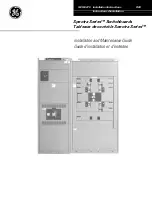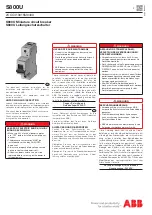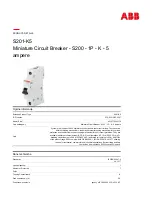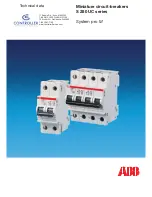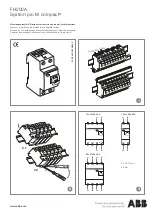
SECTION 5-Breaker Operation
A breaker may be equ ipped to operate either manually
or electrically. Both types of operation resu lt i n the same
fast-closing movement as far as the contact action is
concerned. The variation is in the way energy is stored i n
t h e closing spring, and how it is released.
5.1
MANUAL CLOSING
Manually operated AKR breakers are constructed with
front-mounted handles. Handle operation resets the
mechanism and fully charges the closing spring. A com
p lete charge is accomplished by cranking the handle
through one cycle (1 35-degree swing). The CLOSE but
ton mounted on the escutcheon, is used to manually close
the breaker contacts and the TRIP button is used to open
them.
If equipped with a closing solenoid, a manual breaker
may be closed remotely by a control switch or relay.
Before this can be done, however, the closi ng spring has
to be charged by hand. The closing solenoid is an op
tional accessory and is not suppl ied un less specified i n
the breaker order.
CONTROL
SOURCE
�r
'Ix
G l
5.2 ELECTRICAL CLOSING
On electrically operated breakers the closing springs are
charged by a gear motor. With the springs discharged,
voltage applied to the control circuit will energize the motor
through the "G" switch contacts - see Fig.
9 .
The motor,
through the gear reduction output crank, compresses the
closing springs until they are fully charged. As this fully
charged position is reached , mechanically operated
switches " F" and "G" reverse their shown position, the "G"
switch deenergizing the motor and the
"
F
"
switch estab
l ishing a circuit to the
"
X
"
relay. At the same time , a
mechanical prop is positioned to prevent the discharge of
the fully charged closing spring.
With the closing spring propped fully-charged, the
breaker is ready for closing. This may be accomplished
electrically by depressing the closing switch " PB" on the
breaker (if so equipped) or by a remote closing switch.
Operation of the closing switch energizes the "X" relay,
which in turn energizes the closing solenoid "CC". This
removes the prop, releasing the closing springs to close
the breaker.
As the closing solenoi d is energ ized, it energizes anti
pump relay
"
W
".
If the closing switch is maintained
closed , the anti-pump relay will remain picked-up to
prevent a second closing operation on the breaker in the
event it is tripped open automatically. The closing im
p ulse must be released and reapplied before a second
closing operation can occur.
The closing springs on electrically operated breakers
can be manually charged . The breakers can also be man
ually closed . Refer to Section 5.4 for this procedure.
TC
LEGEND
CC -
C LOS I N G S O L E N O I D
F -
CUTOFF SWITC H , C L O S E D
W H E N CLOS I N G S P R I N G IS
F U L LY C H A R G E D .
G -
C UTOFF SWITC H . OPEN WHEN
C L O S I N G S P R I N G I S
F U L LY CHARG E D
L -
A U X I LIARY SWITCH
M -
C H A R G I N G MOTOR
P B -
C LO S E P U S H B UTION O N
B R EA K E R E S C U T H E O N ,
O P T I O N A L .
TC -
S H U NT TR I P D E V I C E
W -
ANTI - P U M P R E LAY
X -
CONTROL R E LAY
FIG. 9 - ELEMENTARY DIAGRAM FOR ELECTRICALLY OPERATED DRAWOUT B R EAKER.
CONTACT POSITIONS ARE SHOWN WITH BREAKER OPEN AND CLOSING SPRINGS DISCHARGED.
TYP #1 83L71 2 "R" SERIES
1 1
www
. ElectricalPartManuals
. com

































